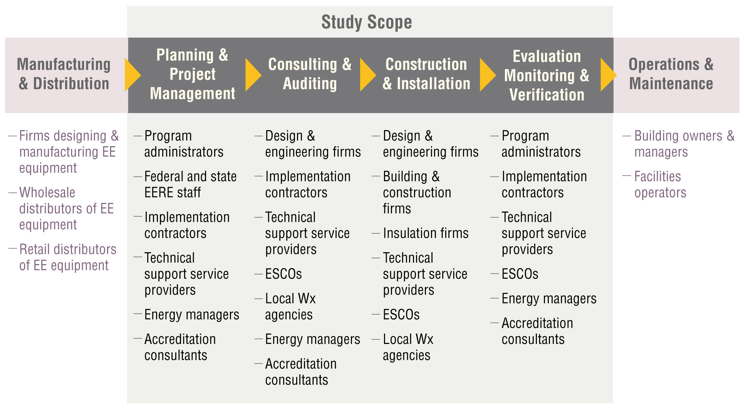Technical contact: Charles Goldman (510) 486-4637, [email protected]
A new study by scientists at the Department of Energy’s Lawrence Berkeley National Laboratory (Berkeley Lab) examines the workforce needs of the energy efficiency services sector, and finds that the speed with which employment will grow will depend in part on how effectively the nation deploys training and education programs for the energy efficiency workforce.
“There is a shortage of formal training programs in energy efficiency, and an extremely high demand right now, thanks to the infusion of funding for energy efficiency from the growth in ratepayer-funded utility programs and federal and state budgets devoted to efficiency, for example, in programs funded through the American Recovery and Reinvestment Act,” says Charles H. Goldman, a scientist in the Environmental Energy Technologies Division of Berkeley Lab. Because of this growth, Berkeley Lab researchers decided to examine whether education and training programs were adequate to meet the workforce needs of the next ten years. The study began in 2008, before the passage of the Recovery Act.
The new report defines an energy efficiency services sector (EESS) that consists of several distinct types of occupations. They include:
- Program administrators who plan and manage energy efficiency projects and programs;
- Energy efficiency consulting firms who assess facility energy use and recommend efficiency retrofits, implement energy efficiency programs, or who design homes and facilities to be energy-efficient;
- Construction and installation firms and tradespeople who build new, or retrofit existing homes and buildings for energy efficiency; and
- Energy Service Companies (ESCOs) who develop and construct comprehensive energy efficiency projects, and monitor and verify that energy efficiency retrofits deliver energy savings.
The study scope does not include those who maintain and operate buildings (building owners, managers and operators), or companies that design, manufacture and distribute energy efficient equipment. “The narrow focus of this study is designed to allow us to estimate the size of the workforce that provides energy efficiency services,” says Goldman, “and determine whether the education and training programs designed to retrain existing workers and train new workers in this market segment are adequate to meet the coming demand.”
The study also does not address the renewable energy workforce, or any energy supply-related market segment.
“A key purpose of this study,” says co-author Jane S. Peters “is to define the energy efficiency workforce sector, including occupations, employer needs and current education and training approaches, which has not been explored in detail in past studies.”
Growth in the size of the workforce anticipated
In a companion study, which has not yet been published but is briefly summarized in the current study, the research team estimates that the size of the energy efficiency sector workforce is currently at about 120,000 full-time equivalent workers (or person-year equivalents, PYE). Because many people in the sector only spend part of their time conducting energy-efficiency related activities, or only work part-time, they estimate that this equates to total employment in the sector of about 400,000 people. Modeling the expected growth of the sector given current and estimated future funding, the team expects it to grow to anywhere from 220,000 PYE in the low-growth scenario to 380,000 PYE in the high-growth scenario by the year 2020, which may represent about 1.3 million people.
The research team conducted interviews with more than 350 program administrators, education and training providers, implementation contractors, energy services companies (ESCO), representatives of professional and trade associations and sector experts. This included interviews with almost 200 representatives of the major building trade unions, industry associations that represent professional groups (e.g., architects and engineers) or technicians involved in the building and construction industry (e.g., sheet metal workers, electrical and HVAC contractors), including the American Institute of Architects, American Society of Heating, Refrigerating and Air-Conditioning Engineers, American Society of Mechanical Engineers, Associated General Contractors, Association of Energy Engineers, Insulation Contractors Association of America, National Association of Home Builders, and others.
They also identified 492 higher education or training programs and conducted a screening analysis to identify engineering, architecture, policy, building trades technical training, and interdisciplinary programs whose curricula met minimum criteria of a specific emphasis on energy efficiency. Research team members interviewed staff at 33 of the educational programs.
Three primary bottlenecks to expanding the workforce
First, there is a shortage of trained, experienced energy efficiency program managers—the senior management staff who have years of experience in their field. This, in turn, reduces the mentoring available for the next generation of staff in energy efficiency services firms.
Second, is the shortage of experienced energy efficiency engineers, in part because of the lack of formal training programs available: “Many engineers are also unaware of energy efficiency as a career path. Moreover, training for mechanical and electrical engineers provides little specific emphasis on efficiency in how to design HVAC [heating, ventilation, air conditioning] systems energy-efficiently,” says Goldman.
Finally, says Peters, “the building and construction trades and contractors have limited awareness that the energy efficiency service sector is poised to grow significantly, and that their skills will be required as part of this growth.” The building and construction trades also face other barriers to growth, including an aging workforce that will have a significant number of retirements in the next 10 years, and a limited number of skilled trainers available in some regions. She adds: “Not surprisingly, states that have been operating energy efficiency programs for years, such as California, New England, Pacific Northwest, have a better training infrastructure and a larger pool of construction trades trained in implementing energy efficiency projects than states that are just beginning to pursue energy efficiency.”
Need to expand access to energy efficiency training and education
The research team makes several recommendations to enable the EESS workforce to keep up with projected demand.
1. Provide energy efficiency education and training targeted at building and construction trades people.
- Building and construction trades constitute about 65 to 70% of the overall workforce in the EESS, and there is a notable lack of awareness that the EESS is poised for significant growth–especially in states that do not have long-running ratepayer-funded programs
- It will be especially important to integrate building and industrial process system efficiency into existing curricula.
2. Coordinate and track training efforts within states; share best practices across states.
- With stimulus funding, many states are initiating or ramping up a range of training activities that target the EESS. However, it is still challenging to identify those training and education programs that will provide specific EESS education; this information needs to be tracked in a systematic way
- Establishing broad statewide education and training efforts like New York State Energy Research and Development Authority’s collaboration with Hudson Valley Community College may be helpful to avoid duplication of efforts
3. Increase short-duration, applied trainings to augment on-the-job training for existing EESS workers and to introduce new entrants to the field.
- Much of the growth in the EESS will come from new entrants who already have some applicable skills (e.g. contractors who become efficiency retrofit specialists)
- There is also strong demand for up-to-date training for those who are currently employed in the EESS but who need to update or augment their skills
- Mid- and senior-level engineers and managers also need more access to on-the-job and formal training, such as training conferences offered by the Association of Energy Service Professionals and the Certified Energy Manager certificate program offered by the Association of Energy Engineers.
4. Increase funding to “train the trainers.”
- Projected growth in training needs indicate that resources for training trainers is an urgent need.
- The Building Performance Institute, which provides certifications for residential retrofit contractors, experienced 5-fold increase in number of certifications between 2005 and 2008, and believe the number will almost triple between 2008 and 2009.
5. Prepare the next generation of EESS professionals.
- The interviews showed that most professional roles within the EESS require at least a four-year degree, but few colleges or universities offer EE-specific curriculum and those that do stated that funding to grow these programs was extremely limited in most cases. Funding is needed to support new and expanded EE-related programs.
- Industrial Assessment Centers have been a successful model to provide energy efficiency services to industry and a training ground for engineering students. Similar centers could be developed in conjunction with college-based engineering, architecture, planning, and policy-focused programs.
Berkeley Lab is a U.S. Department of Energy national laboratory located in Berkeley, California. It conducts unclassified scientific research and is managed by the University of California. Visit our website at http://www.lbl.gov.
The report, “Energy Efficiency Services Sector: Workforce Education and Training Needs” was written by Charles H. Goldman, Elizabeth Stuart and Merrian Fuller of Lawrence Berkeley National Laboratory and Jane S. Peters and Nathaniel Albers of Research Into Action, Inc.
It was funded by the Department of Energy’s Office of Energy Efficiency and Renewable Energy, Weatherization and Intergovernmental Program, and Office of Electricity Delivery and Energy Reliability, Permitting, Siting and Analysis.
It may be downloaded here.

